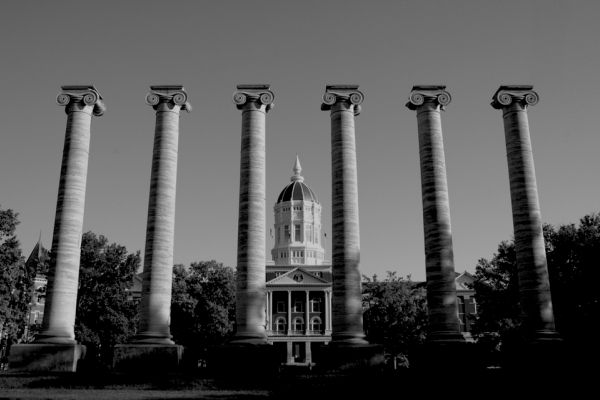We have witnessed a remarkable series of events on the Columbia, Mo., campus of the University of Missouri this week. The university president and the chancellor of the Columbia campus resigned Nov. 9 in response to protests claiming that university leadership had failed to appropriately address and respond to a toxic racial climate on campus.
The recent racist incidents, which many students and faculty felt the administration had failed to confront, reveal a stunning lack of empathy for students of color at the university. They include: racial slurs hurled at a black student body president and a black student organization, and a swastika painted in human feces on the wall of a residence hall.
But these specific incidents merely allowed a long-simmering stew of disrespect, verbal attacks, and marginalization of students of color to come boiling to the surface.
The Columbia campus of the University of Missouri is only a two-hour drive from Ferguson, Mo. When Michael Brown was shot in August 2014, protesters took to the streets of Ferguson every night, and student activists from Mizzou were among them. They saw what standing up to entrenched institutional racism looked like, and they saw that victories could be won with non-violent protest.
But those same students, including a 25-year-old graduate student named Jonathan Butler, saw more than that. They saw how deep the disconnect was at their own school, between themselves and many of their classmates, who are 77 percent white. It became clear that many of their white classmates simply didn’t understand, or were openly hostile, to what the Black Lives Matter movement is all about. They saw that same disconnect between themselves and many of their professors, who are 75 percent white.
They also learned that their experience was shared by some of the faculty of color, like Dr. Cynthia Frisby, an 18-year veteran of the prestigious Missouri School of Journalism, who recently wrote that she has been called the n-word “too many times to count” over the course of her time at Mizzou. And most of all, they felt that disconnect from the white leadership of the university, whose ignorance of or indifference to the lived experience of many students and faculty of color made them seem out of touch at best.
This fall, when ugly racial incidents were once again aimed toward students of color, many of them decided they had had enough. As their protests were met by the administration with puzzlement and foot-dragging instead of compassion, solidarity, and action, the students’ focus turned towards replacing that leadership.
Jonathan Butler, who had become an increasingly prominent student activist at Mizzou since Ferguson, announced Nov. 2 that he would be embarking on a hunger strike until either he was dead or the university president left office. He signed a “do not resuscitate” order and updated his will. This courageous and self-sacrificial action was an important turning point. As his fellow students saw what he was doing, concern spread among his peers and the faculty that Butler’s life was truly on the line.
His extraordinary action was exemplary of how non-violent action that risks an individual’s safety, security, and even life can inspire others to act — even a football team!
Butler’s fast caused members of Mizzou’s football team to step into the protest. Several football players are friendly with Butler and respected his leadership in the movement against racism on campus. To them, this went beyond the issues at stake — they believed Butler when he said he was willing to die for his beliefs. More than 30 black players took the unprecedented step of refusing to practice or play football until Butler began eating again — meaning until Mizzou President Tim Wolfe resigned or was removed from office. The rest of the team and the coach closed ranks behind these players, and no one practiced last Sunday.
With a game coming up against BYU this weekend, Mizzou would have had to pay BYU $1 million if they were forced to forfeit and the loss of TV rights and advertising would have made the cost even higher. Big money has infused Division I college football and basketball for many years now, and the student athletes are just about the only ones not seeing much of it. But because so much money is at stake, these athletes nevertheless can wield tremendous power. In this case, Mizzou’s football players wielded their power to stand behind Jonathan Butler, to take a stand against a campus environment toxic to students of color, and to topple the head of the university.
Athletes playing for schools all over the country have now seen this, and many of them have woken up to the power they have and can wield for moral causes like this one. Only time will tell where this will lead. Other student activists have also taken note, which has energized or helped jump-start protests at other schools.
A friend of mine who was a tackle on the Ohio State football team agreed that the players provided the “tipping point” in the Mizzou crisis. And though the football players would not likely have acted without the sacrificial non-violent action of the student fast, he sees their solidarity as a potential “turning point” for college athletes on other campuses.
A shakeup of campus leadership will not by itself lead to racial justice, healing, and reconciliation at Mizzou. Much more time and hard work will be required from students, faculty, and administrators. But what this series of events does show is the chasm that sadly still exists in the experiences and therefore perspectives of most white people compared to most people of color.
White people need to learn to truly hear, acknowledge, understand, and act on the pain of black and brown people in order for our universities, workplaces, communities, and churches to experience the racial healing they so desperately need. But it is encouraging that since the Ferguson movement gained national attention, people of color and their white allies have become increasingly aware of their power to stand up to oppressive systems, and have decided they’re done waiting for these systems to fix themselves.
Got something to say about what you're reading? We value your feedback!

